Insights on Wave Power
A quick guide for understanding the power and potential of our global ocean.
How Wave Energy Works
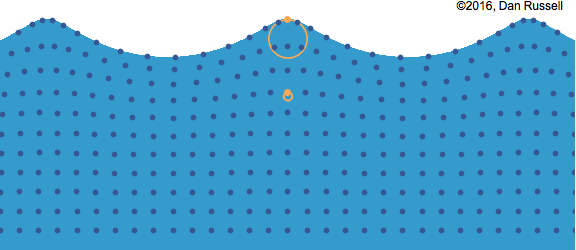
Earth is a water-world. More than 70% of our planet’s surface is covered by an ocean that is ceaseless in motion. All of this motion – from surging tides, coursing currents, and rolling waves – produces what is known as hydrokinetic energy.
Ocean waves pack the strongest degree of power in the water-world, ranking the greatest in terms of levels of marine energy resource potential in the United States. For perspective: on the West Coast, wave energy has a potential of 250 TWh/yr, equivalent to 67% of the region’s net electricity generation in 2019, which is enough to power 23 million homes. CalWave is working to harvest and convert this energy into cost-effective and reliable electricity – but how are ocean waves converted to electricity, exactly? The process that begins with the sun:
1. Wind flows across the ocean and creates waves
Wave energy is, essentially, a condensed form of solar power produced by wind action. The sun heats up air at different places around the globe, which creates wind that blows over the ocean’s surface. Surface waves, like those that crash on a beach, are created by the wind. Ranging in size (from ripples to nearly 100 feet tall), waves can travel thousands of miles before they reach land with almost no energy loss.
2. Waves approach land
Ocean waves are essentially a large composition of water waves with different frequencies and amplitudes interacting with each other. On top of that, the height and length of individual ocean waves can be impacted by environmental influences such as seafloor shape and slope, and of course, the weather.
3. Waves encounter technology
Ocean waves are converted to electricity through wave energy converters, or WEC, devices. Full-scale WEC devices are typically expected to be anchored miles offshore in deep water where wave energy is strongest. WECs can extract energy from incident ocean waves via a multitude of different motion patterns and wave characteristics, and directionality influence what the ideal pattern to extract the most energy looks like.
Identifying the type of machine that can most-effectively do this work has been a key goal for the U.S. Department of Energy.
The Wave Energy Prize, an 18-month competition sponsored by the U.S. DOE, highlighted a variety of promising devices that advanced the energy capture potential of WECs. CalWave was recognized and awarded for our xWave device in this competition.
4. Technology convert waves into electricity
In short, a WEC device is a collective term for a machine that converts the incident ocean waves into usable energy such as electricity. There are many different proposed approaches to harness wave energy but a common approach is to extract the kinetic energy of a wave energy absorber via a suitable drivetrain, similar to a wind turbine’s drivetrain.
Ultimately the kinetic energy leads to turning a shaft connected to a generator and that motion creates electricity.
5. Electricity is applied to the grid or other needs
Electricity from converted ocean waves is transported via export cables back to shore and could power swaths of coastal homes and businesses. In fact, developing just a third of the available wave energy near Pacific states with U.S.-made equipment could support 33,000 jobs and meet up to 30% of West Coast electricity demand. Wave energy is highly predictable and can be developed close to load centers to reduce transmission needs and ease integration onto the grid. Additionally, wave energy could power distributed applications in the near term, like desalination plants—which remove salt from salt water to benefit water-insecure communities and military bases.
The Potential of Wave Power
Ocean waves are a powerful, yet untapped source of renewable energy.
Wave power has the technical feasible resource potential to meet 30% of the United States’ electricity demand, equaling $120B in the total addressable market. Currently, this potential completely unused.
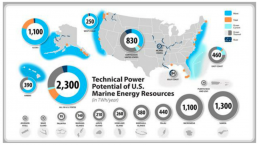
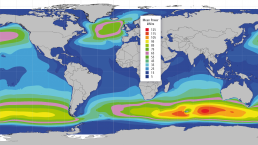
Wave power is stable and abundant.
Wind and solar are volatile.
The Benefits of Wave Power
Consistent
Because waves are always in motion, energy can be harnessed continuously. It's available day and night, throughout every season.
Predictable
Wave energy can easily be forecasted days in advance. Complementing it with other renewables allows for a reliable power supply.
~30-50x More Energy-Dense
It's the most concentrated form of renewable energy on Earth, with power density much higher than that of solar and wind.
Clean
Wave energy has one of the lowest lifecycle emissions and forecasts project that it has the ability to displace up to 1.38 - 1.9 GtCO2 emissions equivalent annually.
Daily Variability of Renewables
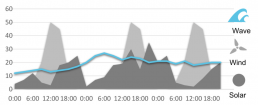
Annual Variability of Renewables
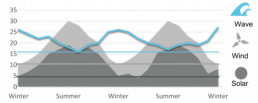
The variability of wave energy potential does not drop as low as other forms of renewables.
Note: The plot of variability is heavily location dependent. This particular example is from a location in California and can look entirely opposite in another country.